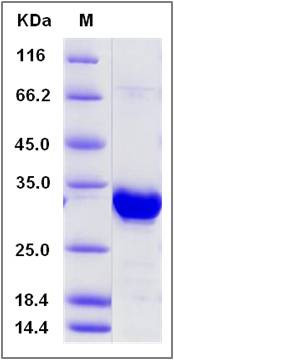Human ING5 Protein (GST Tag)
p28ING5
- 100ug (NPP4024) Please inquiry
| Catalog Number | P13917-H09E |
|---|---|
| Organism Species | Human |
| Host | E. coli |
| Synonyms | p28ING5 |
| Molecular Weight | The recombinant human ING5 /GST chimera consists of 283 amino acids and has a predicted molecular mass of 32.9 kDa. It migrates as an approximately 33 kDa band in SDS-PAGE under reducing conditions. |
| predicted N | Met |
| SDS-PAGE |  |
| Purity | > 95 % as determined by SDS-PAGE |
| Protein Construction | A DNA sequence encoding the mature form of human ING5 (Q8WYH8-2) (Glu36-Gln84) was fused with the GST tag at the N-terminus. |
| Bio-activity | |
| Research Area | Cancer |Signal transduction |Other Related Intracellular Topics |Cellular Senescence and Pathways in Aging |DNA Damage and Repair |
| Formulation | Lyophilized from sterile PBS, pH 7.4 1. Normally 5 % - 8 % trehalose, mannitol and 0.01% Tween80 are added as protectants before lyophilization. Specific concentrations are included in the hardcopy of COA. |
| Background | ING5 belongs to the ING family. It contains 1 PHD-type zinc finger and is a component of the HBO1 complex. HBO1 complex has a histone H4-specific acetyltransferase activity, a reduced activity toward histone H3 and is responsible for the bulk of histone H4 acetylation in vivo. HBO1 complex composed at least of ING4 or ING5, KAT7/HBO1, MEAF6, and one of PHF15, PHF16 and PHF17. ING5 also is a component of the MOZ/MORF complex which is composed at least of ING5, KAT6A, KAT6B, MEAF6 and one of BRPF1, BRD1/BRPF2 and BRPF3. It interacts with EP300 and TP53. MOZ/MORF complex has a histone H3 acetyltransferase activity. Through chromatin acetylation ING5 may regulate DNA replication and may function as a transcriptional coactivator. It interacts with H3K4me3 and to a lesser extent with H3K4me2. ING5 is similar to ING1, a tumor suppressor protein that can interact with TP53, inhibit cell growth, and induce apoptosis. It can bind TP EP300/p300, a component of the histone acetyl transferase complex, suggesting its involvement in TP53-dependent regulatory pathway. |
| Reference |
